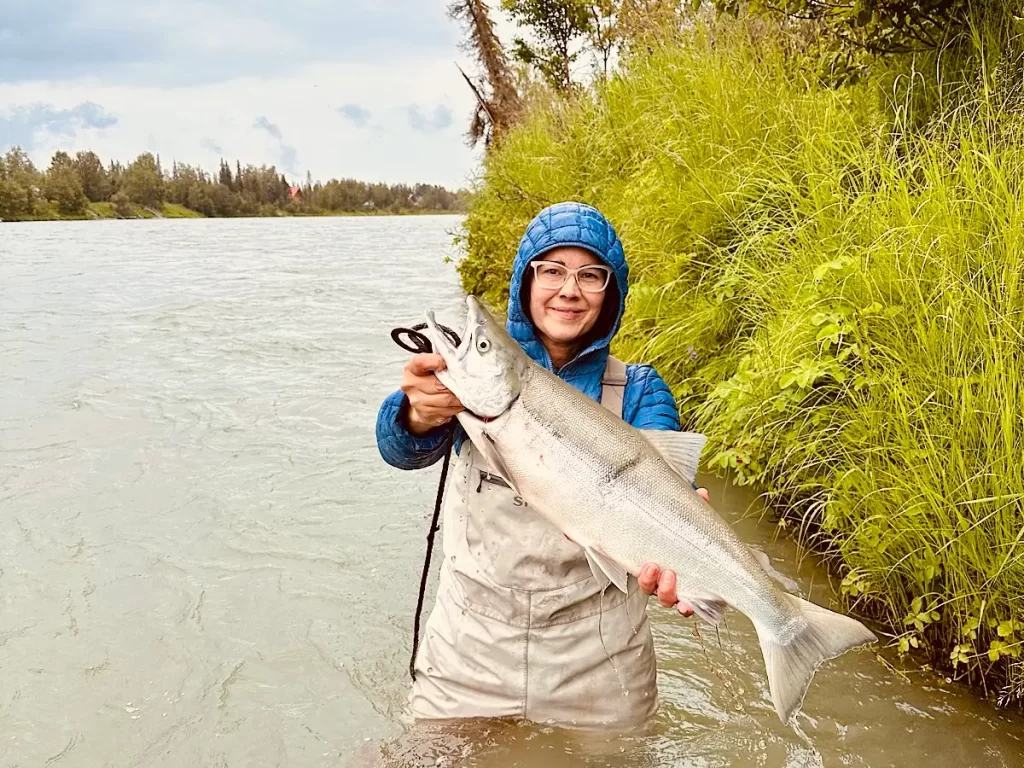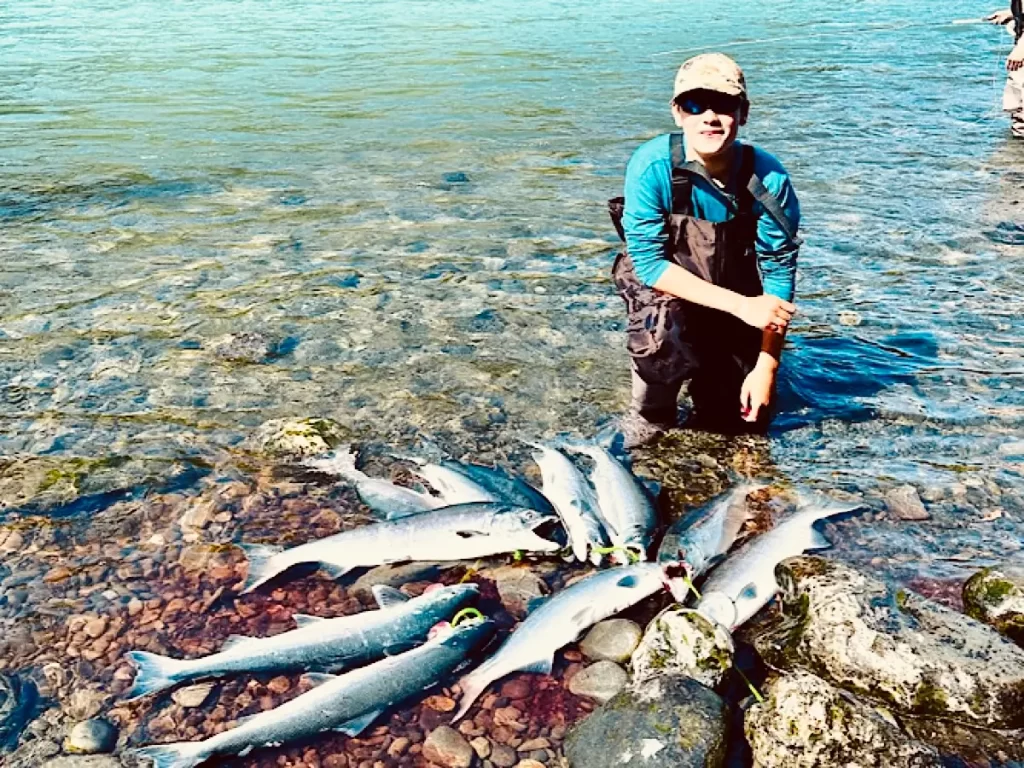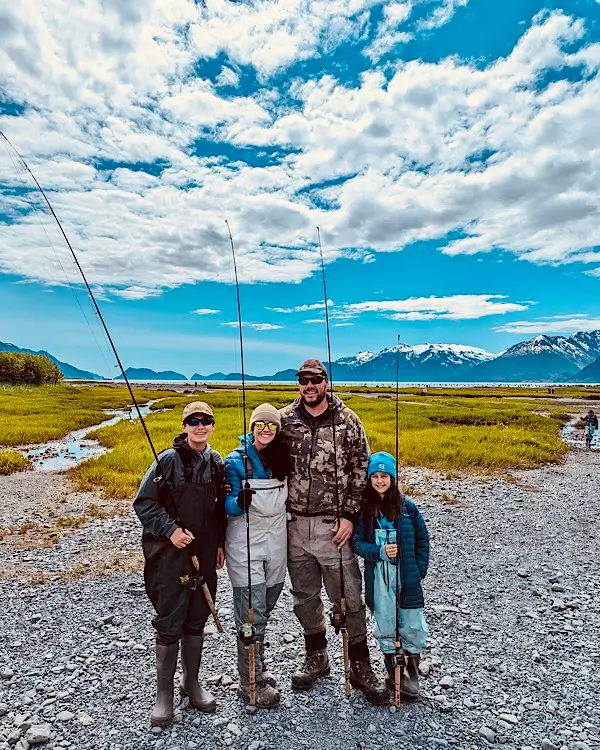By Eric | Updated May 17, 2024
Estimated reading time: 14 minutes
Learning how to floss for salmon on the turquoise Kenai River can take practice, but it’s easy once you learn how. If you plan to catch some salmon on the Kenai River in Alaska by rod and reel, you must know how to floss for these fish correctly to increase your chances of success. Flossing for salmon on the Kenai River in Alaska is a bucket-list experience not to be missed!
Flossing for salmon is not the same technique as snagging salmon. Snagging salmon on the Kenai River is illegal. The technique you will learn here is how to correctly floss salmon on the Kenai River legally.
Alaska is home to the largest population of salmon in the United States. Over 1.5 million sockeye (red) salmon make their way up the Kenai River each year. There are two specific salmon runs, an early run (peaking in mid-June) and a late run (peaking mid-July). Go with us on a fishing adventure to learn how to fish for these amazing aquatic animals.

What is flossing?
Flossing for salmon refers to using a unique technique to catch fish, typically sockeye salmon, by rod and reel. These fish are just starting to make their way to their spawning grounds. Once sockeye salmon enter the river to spawn, they stop feeding.
In other words, they are usually not going to bite your hook intentionally. However, these fish have mouths that are continually opening and closing. The fact their mouths move in this way will help you catch them by flossing (we’ll explain how below).
There are times when sockeye might bite your hook if it’s aggravated. There’s also a technique used to troll for sockeye with plugs when salmon reach their spawning grounds, such as Skilak Lake.
However, for the purpose of this article, we’re going to assume flossing is done successfully through technique rather than a salmon actually biting the hook.
How to floss for salmon?
The idea with flossing is that a line weighted with a lead weight with a hook drifts in front of a fish and goes between their upper and lower jaw as it’s pulled to the surface. The fishing hook needs an attractor, like a plastic bead or piece of yarn, to comply with Alaska fishing regulations.
This line runs through their teeth, essentially “flossing” them. If you’ve never flossed before, you don’t have to worry. This post will provide detailed instructions on flossing for salmon on the Kenai River in Alaska, arguably one of the best salmon rivers on the Kenai Peninsula.
It’s not hard to catch fish once you get the hang of it. In no time, you’ll be flossing your way to a stringer of sockeye salmon, ready for your freezer or grill.
Planning a last-minute fishing trip on the Kenai River in Alaska to floss for salmon?
If you’re planning a trip to floss salmon on the Kenai River in Alaska last-minute, ensure you have your lodging and bookings scheduled ahead of time! Below are some suggestions for you next family travel adventure.
Best hotels and lodging near the Kenai River in Alaska:
- Best Western King Salmon Inn: 35546A Kenai Spur Hwy, Soldotna
- Quality Inn Kenai: 10352 Kenai Spur Hwy, Kenai, AK; budget hotel
- Aspen Hotel Soldotna: 326 Binkley Circle; river access, freezer space
The best places to rent a car:
- Budget car rental: 305 N Willow St., Kenai; airport access at ENA airport
- Avis car rental: 305 N Willow St, Kenai; also inside ENA airport
- Kenai car rental: 130 N Willow Street, Kenai
Best places to processes salmon caught flossing:
- Custom seafoods: 35722 Kenai Spur Hwy, Soldotna, AK
- Tanner’s Alaskan Seafood: 16050 Sterling Hwy, Ninilchik, AK
- Peninsula Processing: 720 Kalifornsky Beach Rd, Soldotna, AK
How to get to the Kenai River to fish for salmon?
Use this map to locate the Kenai River. Scroll to the left or right, and zoom in with two fingers if using your phone. Click here for directions to the Kenai River.
Salmon flossing setup: what gear to use
First, make sure you have the right gear before you begin flossing. To have the correct salmon flossing setup, you will need a rod and reel, line, weight, and hook.
In addition, you’ll need a salmon bonker, a stringer, a net, and a small tackle box. The rod should be 8-10 feet long, with a medium-heavy power rating.
It’s also crucial to bring the right clothing and other essential fishing gear. Use our Alaska fishing gear pack list to help you bring the right equipment and gear so that you can fish longer. Our packing list will also help ensure you bring the right clothes so that you are more comfortable when you get your chance to fish on the Kenai Peninsula.

What size hook to use flossing for salmon?
I like to use size 6/0 hooks by Gamakatsu to floss for salmon. This size is large enough to hook sockeye in the mouth well. They are also easy to handle and tie due to their larger size. Keep in mind that this size hook cannot be used on the Russian River.
Using a robust drag to fly fish for salmon
The fishing reel should have a robust drag system and good line capacity. You can use a fly rod (my preference) if you want to, but you don’t have to. Conventional rods work, but I think fly-fishermen at least look the part.
Furthermore, at least for me, I have an easier time flossing correctly with a fly rod. If I use a spinning rods or bait caster, the flow of your line retrieve isn’t as good, and results in more snags or foul hook ups. Whichever salmon flossing setup you choose, both will catch fish.

Reverse drag reel
The best fly rods have a reverse drag system. One such reel that I’m aware is a Billy Pate reel (pictured below). A reverse drag system allow a fish to pull line out without putting so much strain on the reel. These reels have great performance but are pricey at round $600.
I love mine, but I will say it’s not necessary. I’ve also seen a lot of people forget their rods and reels and it is not worth the risk when you can get a good setup (rod and reel) for around $150 versus $600+.
Fishing Gear Tips & Advice (Flossing Salmon Sockeye Rig):
- Use a 9 to 10 weight fishing rod
- Use 30-lb test line
- Start with 3/4 ounce weight
- Use one brass triple swivel
- Use an attractor on your hook such as a bead or a piece of yarn
- Stringer to hold your fish (fish and equipment must be kept with you or close by (within 12 feet, check regulations for current statutes)
How to tie a salmon leader?
I recommend using a line that’s 30-pound test. The weight should be heavy enough to keep your line close to the bottom of the river. Start with 3/4 ounces, but you might need to work up to 1 ounce, depending on the current.
Lastly, the hook should be firm and sharp, sufficient to penetrate a salmon’s rigid jaw. You can purchase fishing hardware and gear at Trustworthy Hardware store in Soldotna.
Pro tip: Consider bringing a small sharpening stone to sharpen your hooks. Razor sharp hooks create more hook ups and the hooks dull fast when used on the Kenai River. A simple sharpening of your hook is easy to do and is worth the effort. Plus, you can save a hook rather than just tying on a new one.

The best fishing holes
First, if you want to floss for salmon, make sure you head to the Kenai Peninsula of Alaska. Next, look for good fishing spots on the Kenai River. Most locations along the river where you can fish in waders are excellent. Salmon will run upstream about 2-3 feet from the shoreline, so you do not have to be far into the river.
You want to be in moving water as this allows you to drift your line from upstream to downstream. Once you’ve found a good spot, make sure you have permission from the landowner before fishing, or are on public property. There are plenty of fishing spots on the Kenai River with public access.
Where to floss for salmon on the Kenai River for excellent riverbank fishing:
- Centennial Park (river mile 20.4)
- Soldotna River Walk (river mile 21)
- Swiftwater Park (river mile 23)
- Soldotna Creek Park (river mile 22)
- Funny River Campground (river mile 30.5)
- Bing’s Landing (river mile 39.5)
Flossing salmon technique
Now, it’s time to start flossing salmon. The method involves casting your line upstream at about 9 or 10 o’clock (when facing the river straight out). Then, let the line drift downstream.
The line has a lead weight and a hook with some attractor (i.e., a bead or a piece of yarn) attached. As your line drifts downstream, make sure you are weight is on the bottom of the river or riverbed.
You will feel your weight roll along the rocks through your rod tip. As your technique improves, you’ll feel like Brad Pitt in A River Runs Through It and you’ll become one with your rod.
If the weight is too heavy, it gets caught in the rocks. If it’s too light, you won’t feel it bump the rocks on the river bed. As the tip of your rod is held low and it reaches a 4 to 5 o’clock position, lift the tip of the rod up swiftly.
This motion pulls the hook across the water and hopefully in front of a salmon that has its mouth open. Once you feel a resistance, set the hook firmly and reel in the salmon.
Be patient, as this process may take some time. Kenai sockeye salmon are more enormous and fight harder than most sockeye.

Best time of the year to floss
You’ll want to floss for salmon on the Kenai River when the sockeye salmon are “running” or finding their way upstream to spawn.
As part of the salmon life cycle, salmon come from the ocean and enter the Kenai River to find the very same stream they were born in. Here, they will lay eggs (if female) or disperse sperm (if male) to start the cycle all over again.
The very best time to floss for is typically around the second week of July and extends unto the end of July. Limit are often raised toward the end of July if a certain quota of salmon has passed the weir.
Is flossing for salmon legal? Read the regulations
It’s also important to note that you must follow the Alaska Department of Fish and Game (AKFG) regulations. There may be restrictions on the size and number of salmon you can catch. Be sure to check the regulations before you begin fishing.
The AKFG sometimes puts out emergency orders, requiring immediate changes in fish and game regulations at certain dates. Bottomline, read the regulations, go talk to AKFG and sign up for email alerts regarding emergency orders.
Fish not caught in the mouth (i.e., foul hooked or snagged) cannot be retained. Releasing fish goes for those caught in the gills, too. Even fish that die will be part of the circle of life, so they do not go to waste. Fish foul hooked cannot be removed from the water.
There’s plenty of fish in the river, so follow the rules. Lastly, be respectful of the fish and the environment. Fish carcasses should be thrown in the river, ideally as far away from the bank as possible. When in bear country it’s imperative you are practice good bear safety techniques.
If you catch a salmon, handle it gently and use a net if possible. If you decide to release the fish, do so carefully, ensuring it’s healthy enough to survive. Also, pack out all your trash and respect the natural surroundings.

Now you should know how to floss for salmon
In summary, flossing for salmon on the Kenai River in Alaska can be an excellent way to catch fish if done correctly and responsibly. Remember to have the proper gear, find good fishing spots, floss accurately, follow regulations, and respect the fish and the environment.
Following these instructions will give you a great time and a successful fishing experience on the Kenai River. After having read this article, you should now be familiar with not only how to floss, but also the proper gear to have and regulations to follow.
Flossing for salmon: FAQ
Read the regulations to research hook size and daily fish limit, if any. Or, try to catch a halibut in Homer or Prince William Sound if you have time. In general, fishermen must release king salmon on the Kenai River.
They cannot even come out of the water for a photo. Be sure to use extra caution if you catch a king salmon so that it can be released safely.
- Do I have to use a fly reel to floss for salmon? No, you do not have to use a fly reel or rod. Conventional reels such as spinning reels and baitcasters work and are legal to use.
- Do you have to use an attractor on your hook to floss or fish the Kenai River for sockeye? Yes, this is a legal requirement.
- Can I take photos with salmon when flossing? You cannot remove king salmon from the water on days you cannot retain king salmon. Salmon, such as sockeye that are hooked in the mouth and will be kept are good photo opportunities. Salmon that will not be saved (i.e., snagged or foul hooked) must stay in the water to increase their survival chances.
- Do I have to keep the entire fish that I caught flossing? I see most people keep the fillets only, but realize that you can indeed use the whole fish. If you use the whole fish you will more likely need to harvest less fish for consumption. The head, the collar, the bellies all make great meals if you know how to cook with them. Read our article on filleting a salmon so you can take home as much of your fresh catch as possible.
- Can I use an electronic copy of my fishing license? Yes, an electronic copy of your fishing license is sufficient proof of having a fishing license. However, you will have to electronically sign the document so that it’s valid. Also, ensure you have enough battery life on your phone if you’re going to use it as proof of having a fishing license.
- Do I need to know to ID or identify all types or species of fish that you catch? Yes, in some ways. For example, let’s say you catch a king salmon or rainbow trout and cannot legally keep it or take it out of the water, then you need to know what is and is not a sockeye salmon. If you’re in doubt, release the fish.
Other fishing gear needed to floss for salmon
- Sockeye salmon stringer to hold legally hooked fish (one stringer per fisherman)
- Fish bonker to dispatch a salmon
- Fillet knife (i.e. Dexter knives)
- Small tackle box with appropriate hooks weights, swivels and leader (fishing line)
- Polarized sunglasses (i.e. Costa del Mar)
- Fishing waders: any wader works just make sure that they are long enough. Do not wear shoes, boots or waders with felt on them since they can transfer pathogens and invasive species when flossing for salmon on the Kenai River in Alaska (i.e. Orvis)

How’d we do? If you have more tips and advice on how to floss for salmon on the Kenai River let us know in the comments below. For more fishing adventures or adventures in the water check out other articles on our website. Or, review our Alaska page for more posts on this bucket-list destination.







